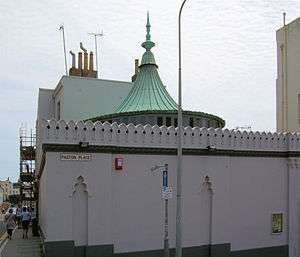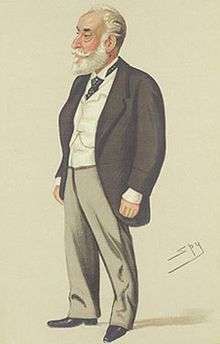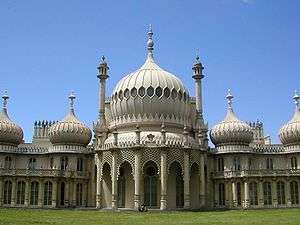Sassoon Mausoleum

The Sassoon Mausoleum is the former grave of Sir Albert Sassoon and other members of his family, including Sir Edward Sassoon, 2nd Baronet, of Kensington Gore. It stands at 83 St. George's Road in Brighton, England.
History

Albert Abdullah David Sassoon was born in Baghdad in 1818 to a prominent, Sephardic Jewish family. After many years spent managing the family's banking and merchant shipping business in Bombay, India, he retired to England where he was created a baronet.[1] He died in Brighton in 1896.
The mausoleum was built in 1892 as a wing of the family home located at 1 Eastern Terrace. The Sassoons are known to have received many distinguished visitors, including Edward VII twice, while he was Prince of Wales.[2] The house no longer survives. In 1933 the remains of the Sassoon family were removed and reburied in the Willesden Jewish Cemetery in London.[3][4]
The former mausoleum was for a time a furniture depository.[4][5] During World War II it was used as an air raid shelter during fierce bombings.[5] In 1949 it was purchased by a brewery for use as a pub - The Bombay Bar.[5] In 2001 the mausoleum housed the Brighton Arms Pub.[6] In 2003 it was bought and the name changed to "The Hanbury Club".[4]
In 2006 the mausoleum, which is located in the fashionably Bohemian Kemptown neighbourhood of Brighton, underwent a £60,000 refurbishment. The new decor is intended to evoke the supper clubs of the 1920s and 1930s. The club features live performances of contemporary music.[3][7][8][9][10][11]
In 2011 the mausoleum reopened as Proud Cabaret Brighton.
Architecture
The mausoleum is a single storey building notable for its "flamboyant" trumpet-shaped, Indo-Saracenic dome.[3][12] The copper dome was originally covered in gold leaf. The Indo-Saracenic theme is carried out in lotus-leaf crenellations along the parapet and the lobed arches of the front door.[3] The colourful "Bollywood" ceiling murals were applied by a later owner and are not original to the mausoleum.[3][12]
The circle of pointed horseshoe arch windows on the drum of the dome were restored in the early 21st century.[3]
The mausoleum was an enlarged replica of the marble mausoleum in the courtyard of the Ohel David Synagogue at Poona where Sassoon's father, David Sassoon, was buried.[13][14]
It is a Grade II listed building.[10]
References
- ↑ The London Gazette: no. 26019. p. 545. 31 January 1890. Retrieved 2008-12-28.
- ↑ Fashionable Brighton, 1820-1860, Antony Dale, Taylor & Francis, 1967, p. 167
- 1 2 3 4 5 6 Sharman Kadish, Jewish Heritage in England : An Architectural Guide, English Heritage, 2006, pp. 77-8
- 1 2 3 Sassoon: the worlds of Philip and Sybil, Peter Stansky, Yale University Press, 2003, p. 16
- 1 2 3 Baronet's Tomb to Be Saloon, New York Times, August 28, 1949
- ↑ Mausoleums, Lynn F. Pearson, Osprey Publishing, 2001, p. 29.
- ↑ http://www.thehanburyclub.com/
- ↑ The Argus, Oct. 27, 2006
- ↑ http://www.carling.com/beerfinder/venue_details/916
- 1 2 http://www.viewlondon.co.uk/clubs/the-hanbury-club-review-26087.html
- ↑ http://www.visitbrighton.com/site/tourist-information/news/news-archive/2009/1/9/hanbury-club-wins-bar-award-a59
- 1 2 http://www.buildingopinions.com/Archive/H/hanburyclub.html
- ↑ The Sassoon Dynasty., Cecil Roth, 1941, p. 165.
- ↑ The Jewish Traveller: Bombay, Rahel Musleah, February 2000 Vol. 81 No. 6
External links
Coordinates: 50°49′04″N 0°07′08″W / 50.8178°N 0.1189°W

.jpg)
.jpg)

